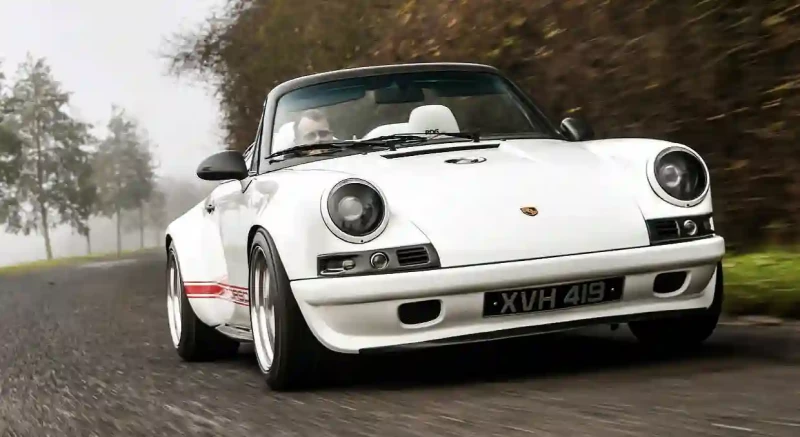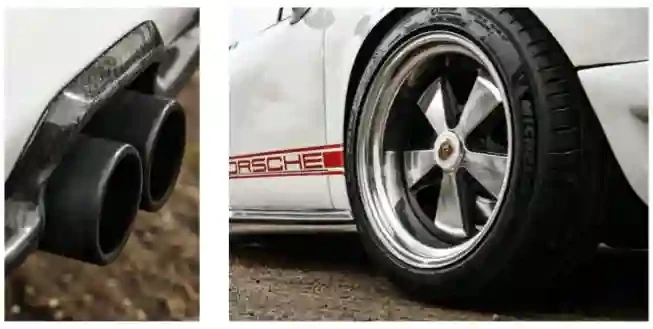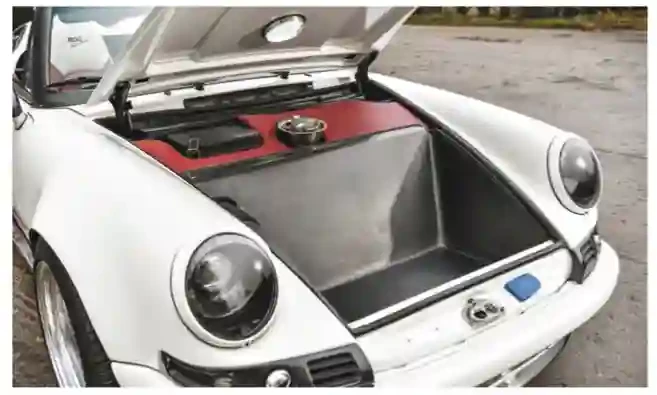RDG Speedster 1991 Porsche 911 Carrera 2 Cabriolet
Is it a Speedster? Is it a Targa? Is it a Coupe? Actually, it’s all three in one. Welcome to David Gawthorpe’s radical and highly transformative 964...
Words Steve Bennett
Photography Chris Wallbank
SPEED ENCORE RDG Speedster 1991 Porsche 911 Carrera 2 Cabriolet
A 964 Coupe, Targa and Speedster in one

What the hell have I just done?! It’s a rhetorical question, although for David Gawthorpe, the query to self was, perhaps, a tad more existential, not that you’d know it now, looking at his unique threeway 964 Speedster/Targa/Coupe. Wondering whether you’ve made the right decision when modifying a car is the moment of darkness before dawn, the exact point a build can stall. It’s the point where folk either power through or give up.
We would probably be in the latter camp, but David is made of sterner stuff. It must be something to do with him being a no-nonsense Yorkshireman — he did indeed power through, but there were moments when digging deep was not the easy option. Let’s be clear, this in no way down to a lack of skill or biting off more than was easily digestible. It was more to do with his unorthodox starting point and the journey from A to B, which vicariously took in most other points of the alphabet, including Z.
This amazing 964 is far from David’s first custom- Porsche rodeo. Indeed, chopping up and restomodding is what gets him out of bed in the morning — he is employed as designer and fabricator for 911 Retro Works, a business well-known to regular readers of Classic Porsche. David, along with company boss, Rick Findlow, is responsible for overcoming the challenges faced when backdating 993s for the pre-1973 look. Given the 993’s complexity and body style, this is no easy task, but fifty cars down the line, Retro Works builds, complete with their distinctive look, have proved themselves more than worthy of occupying their own place in the Porsche scene.

The look is largely down to David. With a BA (Hons) degree in Automotive and Transport Design from the world-famous Coventry University, he knows precisely what’s required when shapeshifting the curvature of the 911. Not that it started there, as he reveals. “My dad was a water colour artist. As a child, my interest in art and design was inspired by him and his work, but as I got older, I also became interested in transport design. I was very much into radio-controlled aircraft and built exacting small-scale facsimiles of many famous aeroplanes.” An art and design course at Huddersfield Technical College followed.
To Coventry for the five-year course, where David was tutored by Simon Saunders, founder and director of the Ariel Motor Company. “That was an eye opener,” David recalls. “I particularly enjoyed learning about clay modelling. It suits the way I work, as opposed to computer-aided design and imaging, including donning 3D goggles for ‘virtual’ design, which is the popular approach today.”
David was one of the Class of ’95 and left Coventry to join internationally renowned industrial and transport design agency, David Carter Associates, based in Warwickshire. Work involved projects for big-name clients, including Volvo. You can’t take the boy away from God’s Own Country for too long, though — he returned to West Yorkshire, got to know Rick Findlow (through mutual interests and participation in windsurfing, no less) and the rest is, as they say, history. It should be mentioned, David’s impressive skills with fibreglass and moulding were honed with his hydrofoil windsurfer, a project undertaken for his degree course. These skills were put to good use when it came to creating panels for Retro Works 993 backdates, where the rear quarter is a complete one-piece section from the doors back.
SEAT OF POWER
Another project to David’s name, and one resulting in him being on television and in newspapers, was his Mini Entertainment Chair. Taking the form of a fibreglass classic Mini front end, it opens up to reveal a gaming seat, steering wheel and pedals, and contains an amplifier and speakers. The original Mini Entertainment Chair resides at The Motorist, an exciting automotive venue (and restaurant) near Leeds. Check it out, if you happen to be passing.

That’s the backstory, but what of the Speedster-styled 911 we’ve come to marvel at, coincidentally, a stone’s throw from The Motorist? It’s important to note, even though David is Rick’s right-hand man at 911 Retro Works, this is an entirely personal project on David’s part and is pitched under his RDG Design banner. We thought it worth mentioning in case you were planning to beat a path to the Retro Works workshop before reading any further. On that note, this glistening white open-top 911 is something of a one off, although David plans to build another two similarly configured 911s from the starting point of an SC and a 993. Then again, this could be your lucky day, because this unique 964-based Speedster is currently for sale.
EXCLUSIVE CLUB
Three years in the making, the influence is clear — from 356 onward, Porsche has regularly included a Speedster in its model line-up. The 964-generation 911 was no exception. Factory 964 Speedsters are out there, but rarity has a price. Primarily for this reason, replicas have always been fair game, although rarely have they been styled as radically as David’s tribute.
It’s fair to say what he has created might be too radical for some Porschephiles. He admits the car evokes strong opinion. “It goes from people telling me how amazing this car is to others asking what possessed me to embark on such a project.” If you’re in the latter camp, you might be placated by the fact that before going under the knife, the starting point for this build was a thirteen-owner 964 Carrera 2 Cabriolet minus its engine and gearbox. Moreover, the car was registered Cat C, which for the benefit of our Stateside readers, means it was previously involved in an accident and the insurer deemed the cost of repair greater than the value of the vehicle. To be clear, this doesn’t mean a Cat C car is necessarily unroadworthy. Quite the opposite, in fact — a Cat C car can be safe to drive, providing it is repaired properly.
Another consideration is the 964’s rapid rise in value in recent years. Where once repair work would have been viewed as uneconomical, it would now be considered a no-brainer and wouldn’t attract insurance reclassification. Even so, as unloved 911s go, this has to be right up there. With this in mind, it’s fair to say David didn’t feel overly precious about his direction of travel. “Had this been a nicely presented 964, I might have thought differently, but I didn’t feel the world owed much to the car and proceeded to use it as the starting point for the build.”
Specifically, the Porsche had received light frontend damage, which was of no real significance, not least because David intended to embark on a process of backdating using front wings, a long bonnet, slam panel, a new front apron and a spoiler, all being offthe- shelf panels designed by David for the occasional 964 backdates Retro Works produces. Likewise, from the sills to the rear, David used the one-piece panel he previously designed, as well as an RS-style rear apron with overriders. Oh, and he added an RS-style ducktail. Easy peasy for a man who can expertly have the parts fitted and painted in three-weeks flat.
There are many one-off details found on this 911, though. For example. Instead of the traditional early-style front indicators and horn grilles, and in place of the rear light units at the rear, David has moulded his own carbon-fibre light clusters. Very neat they look, too. In fact, the more you look at the car, the more you see evidence of old and new meshing together, such as the carbon-fibre front splitter and carbon-inlaid ducktail grille. Carbon has also been used in the construction of the surround for the twin outlet centre-exit exhaust. Carbon side skirts runs along the sills. These are all details unique to this 911, but so far, so relatively conventional, certainly in terms of backdating and restomodding.
The deep dish, three-piece, sixteeninch Fuchs replicas are hugely eyecatching. Many would opt for a satin finish, but if you’re going to be a bear, then be a grizzly and go full polished. Brace yourselves now, because this is where things start to get rather more ambitious. Moreover, it’s where the Porsche style guide is thrown under the bus and David’s background in creative design comes to the fore. You see, there is no flimsy, tent-like Speedster hood here. Instead, David has produced a proper roof arrangement, which can be removed and stored. Clever? Yes, but we’d go as far as to say ingenious, particularly since it means the car can be configured as either a coupe, Targa or — with everything removed — a Speedster.
Starting with a Cabriolet is not only advantageous, but essential. David decided to stick with the original windscreen, eschewing the chopped Speedster-style glass, primarily in the interests of available head room with the bespoke roof closed. He designed and moulded his own take on the Speedster clamshell, complete with its iconic humps. Note the carbon-inlaid scallops on each side. These are important to the functionality of the go-anywhere hood, as we will now attempt to explain.
The structure is formed of three pieces: the side beams and the central roof panel. The beams were by far the most complicated to conceive, design, style and mould. For starters, there was the 911 silhouette to consider. To get the crucial Porsche profile, David utilised lengths of fishing rod to help create the curvature. He then designed the curved carbon-fibre beam to follow the roofline from the rear clamshell to the top of the windscreen. The beam is attached at the rear by way of slotting into the scallops by means of a ball bearing clamp, and to at the front (to the windscreen) using the existing Cabriolet hood socket and fixing. The beam also includes carbon finishing trim sitting flush against the side windows, and an integral rear window sealing against the clam.
As you can see, the central roof panel is formed from carbon-fibre and is moulded to follow the line of the bonnet, sliding into place between the side beams and slotting into the custom carbon windscreen surround. Holding it in situ at the rear is a panel sitting flush between the Speedster humps and acting as a wind break when the roof is fully removed. The three configurations are therefore as follows: with the side beams in place and the roof slotted into position, you effectively have a Coupe; remove the roof panel and the car becomes a Targa; remove the side beams and it becomes a Speedster. Incidentally, with all panels in place for the Coupe look, the driver can be assured David has spent much time and effort on effective waterproofing and drainage to make the concept both quiet, civilised and watertight.
Further cleverness follows in David’s criteria to be able to store the panels in the rear (behind the front seats) with fixings to take the side beams. When one is on top of the other, they form a kind of ‘x’ shape. The roof panel then sits clamped firmly in place on top, via a slot in the custom-made transmission tunnel.
Of course, simply listing the process here doesn’t take into account the sheer complexity and work involved. David is certainly skilled at making it sound simple to the layman. He talks of a ‘no fear’ attitude and of ‘no going back’, the point when it’s hard to see then wood for the trees and the only way forward is by sheer perseverance.
“I had a vision of what I wanted, but I certainly made life complicated for myself,” he says. “I should stress, the difficulties I faced weren’t down to the design process, the fabricating, moulding and making everything work. The ‘what the hell am I doing moment’ probably came when I realised just what it was going to take to get the finished car roadworthy. I’d invested a huge amount of time and money into my unique Speedster concept, as well as its functionality, but I hadn’t accounted for the fact I had to get the car rolling. It had no engine or gearbox, after all.” Indeed, such things don’t grow on trees.
SIX OF THE BEST
Where there’s will and money, there’s a way. Enter Douglas Valley Breakers in Chorley, Lancashire. Main man, Steve Strange, supplied a standard 3.6-litre M64 flat-six and Getrag G50 transmission from a 964 with just seventy-seven thousand miles on its odometer and fully documented history. This was a plug-and-play solution to David’s problem, albeit at a cost of fifteen thousand pounds. “It had to be done,” he shrugs. “If I was repeating this project, however, I would start with a complete car. It would probably be cheaper to do so.” Would he have been hesitant about embarking on such an ambitious project if working with a complete, running 964 without the stigma of Cat C? “Quite possibly,” he admits.
He decided to leave the near 250bhp air-cooled engine in stock specification, save for a stainless steel Milltek sport exhaust, which sounds the part without droning on a long run. The rest of the running gear is standard, albeit replaced with new for old as necessary. “Looking back, this was pretty much a ground-up restoration,” David smiles. New brakes, brake lines, suspension bushes and even the heater fans were replaced. “They were squeaking in that 964-specific way.”
He shunned the commonly appointed bullet-style door mirrors in favour of 993 ‘teardrop’ parts, citing the fact you can actually see out of them. Their cases are finished in exposed carbon-fibre, thereby complementing the rest of the exterior detailing. In the interests of adequate night vision, the standard headlights have been binned in favour of powerful Hella LED illumination.
It would be remiss — perverse, even — of David not to apply his talents to the interior. Lightweight carbon door panels and cappings are of his own design and look great, as well as being practical in resisting the warping traditional plycovered lightweight door trim can suffer. Carbon extends to the dash centre and knee pad, while chrome trim lifts the instrument cluster. The standard 964 pews, meanwhile, have been substituted with later 993 seats, which have been re-modelled with some of their base foam removed to make for a lower seating position. Trimmed in red and white by D&G Auto Trimming in Washington, they contrast nicely against the charcoal carpet.
Modern inclusions, such as USB charging points, add welcome functionality. A clean-looking Blaupunkt Milano 200 BT bridges the gap between retro and modern by pairing Bluetooth and smartphone connectivity with compact disc playback. Perhaps in a nod to the Mini Entertainment Chair, David couldn’t resist hooking the head unit up to a seriously kick-arse amplifier and speaker set-up comprising a 600wpc Hertz amp, an eight-inch bass box and six Audison speakers. The subwoofer, behind the driver’s seat, “has the desired vibratory effect”, says David, laughing.
It’s a lot to take in, but is pleasingly different to the usual reverence making modified and backdated 911s so predictable, so formulaic in recent years. David’s vision and this project is, perhaps, in keeping with some of Rinspeed’s past Porsche output — it’s different, clever and works on multiple levels. It’s a Porsche Transformer. And, as mentioned earlier, it could be yours. Yes, the time has come for David to recoup some of what he has invested, which is a considerable amount for this prototype. The money hasn’t been wasted — the proven architecture will form the basis of the next two builds. As he openly admits, the enjoyment and motivation he gets from a project like this is in its creative development, not so much driving and ownership. “Maybe I’m a bit eccentric?” he ponders. Maybe you are, David, but from time to time, the sometimes po-faced Porsche scene needs a healthy dose of eccentricity.

PLEASINGLY DIFFERENT TO THE USUAL REVERENCE MAKING BACKDATES SO PREDICTABLE IN RECENT YEARS

Above Some say the 911 restomod scene is a tad overcooked, but there is no slowing boutique restoration shops from producing reimagined 964s, as the RDG Speedster demonstrates.
Above Interior is a sumptuous blend of red and white leather, a colour scheme reflected in the exterior paintwork and red side stripes.
Below Following time spent toiling over automotive design projects for major manufacturers, including Volvo, David’s working life is spent backdating 993s.
HE DESIGNED AND MOULDED HIS OWN TAKE ON THE SPEEDSTER CLAMSHELL, COMPLETE WITH ITS ICONIC HUMPS
Above The first of three 911 Speedster builds David intends to market, this being a 964, the forthcoming choptops being based on an SC and a 993 Cabriolet. Facing page Distinctive ‘double hump’ rear lid is a 911 Speedster hallmark.
TIME SPENT WORKING FOR PORSCHE MOTORSPORT OUTFIT, SCUDERIA ELEVEN, WHERE HE RESTORED 911 RACE CARS


